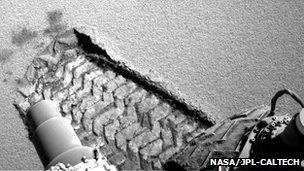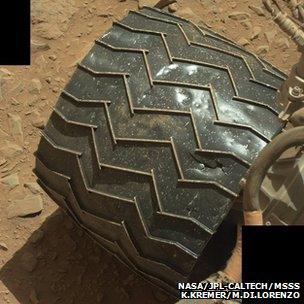Nasa's Curiosity Mars rover looks to 'jump' sand dune
- Published

Smoother terrain ahead: Looking over the top of the dune at Dingo Gap
The Curiosity Mars rover is to try to drive over a one metre-high dune.
The sand bank is currently blocking the robot's path into a small valley and a route with fewer of the sharp rocks that lately have been making big dents in the vehicle's aluminium wheels.
US space agency engineers will take no risks, however. The rover will be commanded initially to climb only part way up the dune to see how it behaves.
The team is mindful that Nasa's Spirit rover was lost in a sand trap in 2009.
And the Opportunity rover, which has just celebrated 10 working years on the planet, very nearly went the same way in 2005 when it became stuck for several weeks in a deep dirt pile later dubbed "Purgatory Dune".

Curiosity has already pressed a wheel into the base of the dune
Curiosity has already had one scuff at the base of the barrier, using a wheel to test the sand's consistency.
The robot would have no problem managing the incline but mission planners will be concerned about the potential for any rocks hidden inside the dune to damage or snare Curiosity.
Engineers believe the path ahead between two scarps referred to as "Dingo Gap" will be kinder on the rover's 50cm-diameter wheels.
These have been taking a hammering during the one-tonne vehicle's traverse across the base of Mars' equatorial Gale Crater.

The wheels on Curiosity have taken some punishment in nearly 5km of driving
Recent close-up pictures reveal multiple punctures, rips and dimples in Curiosity's metal "tyres".
Getting through Dingo Gap would allow the rover to access smoother ground as it heads towards future science targets.
The next of these is a location called KMS-9 where scientists hope to drill into freshly exposed bedrock and look for traces of any complex carbon chemistry that might be present. Such signatures would add to the picture being built of Gale as a place where microbial life could have flourished billions of years ago.
Curiosity's ultimate goal is to get to the foothills of the big mountain that dominates the crater floor. This is still several kilometres to the south and west of its present location.
Since landing in August 2012, the robot has clocked almost 5km on its odometer.

Curiosity has now driven right up in front of the dune
Jonathan.Amos-INTERNET@bbc.co.uk and follow me on Twitter: @BBCAmos, external
- Published24 January 2014
- Published9 December 2013
- Published26 September 2013
- Published19 September 2013
- Published6 August 2013
- Published10 July 2013
- Published31 May 2013
- Published30 May 2013
- Published8 May 2013
- Published8 April 2013